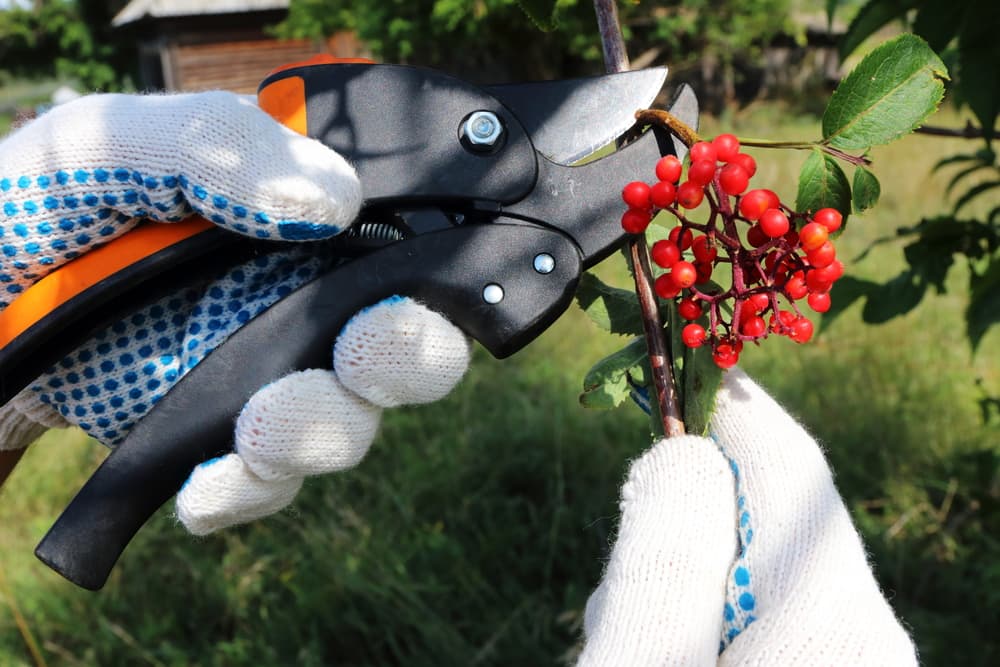SHRUBS > SAMBUCUS
Chris is a gardening writer and nature enthusiast. He graduated from Oxford Brookes University in 2022 with an MA in Psychology. Chris works with the Leeds Green Action Society, helping their food cooperative by growing various fruit and vegetables on their two allotments in Hyde Park, Leeds.
Reviewed By COLIN SKELLY

Colin is a Horticulturist and Horticultural Consultant with experience in a range of practical and managerial roles across heritage, commercial and public horticulture. He holds the Royal Horticultural Society’s Master of Horticulture award and has a particular interest in horticultural ecology and naturalistic planting for habitat and climate resilience.
Contributions From BEN RASKIN

With 20 years of commercial growing experience under his belt, Ben Raskin is now the Head of Horticulture & Agroforestry at the Soil Association. He is also the author of several gardening books, including Zero Waste Gardening and The Woodchip Handbook. Ben is a full member of the Garden Media Guild.
SAMBUCUS GUIDES
Black Lace
You’re probably more familiar with some of the plants in the Sambucus genus – plants like Black Elder, European Elder, or Elderberry.
Growing Sambucus nigra in your garden guarantees a striking twist on the common elder.
This plant can be a bushy shrub or small tree, and puts forth tiny jet-black fruits each autumn.
“One of my favourite slow-growing trees is a Sambucus nigra,” shares Tree Expert Ben Raskin.
“It took 15 years in my old garden to get to size, but when it did, it was truly lovely.”
The dark leaf colour brings a whole new visual interest, and you can use the berries in the same way.

The pink flowers give way to dark berries, with the whole thing underpinned by dark purple, almost black leaves.
Overall, a hugely attractive plant to incorporate into your garden.
Elder is a native to Europe and the Middle East, and in the UK, is commonplace in hedgerows and other wild growth areas.1Sambucus nigra. (n.d.). Kew Royal Botanic Gardens. Retrieved March 23, 2023, from https://powo.science.kew.org/taxon/urn:lsid:ipni.org:names:30122169-2
Chances are you’ve seen it plenty of times, even if you didn’t recognise it.
Overview
| Botanical Name | Sambucus nigra |
| Common Name(s) | Black Lace, Elder, Elderberry |
| Plant Type | Shrub / Fruit |
| Native Area | Europe, North Africa, South-West Asia |
| Hardiness Rating | H6 |
| Foliage | Deciduous, pinnate leaves |
| Flowers | Cream flowers followed by black berries |
| When To Sow | March, April, May, September, October, November |
| Flowering Months | June, July, August, September, October |
| When To Prune | February, March |
Sunlight
Preferred
Full Sun / Partial Shade
Exposure
Exposed or Sheltered
Size
Height
4 – 8M
Spread
2.5 – 4M
Bloom Time
June – July
Soil
Preferred
Most Soil Types
Moisture
Moist but well drained
pH
Any
Growing as either a shrub or a tree, Elderberry is a great addition to any type of garden.
The black lace cultivar is one of many types, and will grow to a full height of about 1.5-2.5m.
While the other elderberry types might be of interest for UK gardeners, this guide will focus on growing and caring for Black Lace, specifically.
How To Grow ‘Black Lace’
This plant is a fantastic option to grow for its visual appeal – and quite easy to care for once settled.
Exposure
S. nigra is a perennial that grows best in full sun exposure, with a south- or west-facing aspect.

It works best in the middle or back of a border, thanks to its height.
The plant is hardy, meaning it will easily survive whatever conditions a British winter throws at it, and it’s not fussy with soil composition.
Planting
If you’re growing S. nigra from seed, you should look to plant them directly into your garden in autumn, from September through to November.
There’s no need to sprout these indoors, or to grow them in a nursery.
“Sambucus seeds require a period of stratification, which is a period of cool temperature exposure before they will germinate,” says Colin Skelly, a Horticultural Consultant.
“One way to do this is to plant outside, but be sure to mark where you have planted the seed and keep it weed-free. You can sow in trays outside or in cold frames as an alternative.”
Just remember that growing from seed will give you a long wait for a mature plant!
Another option is to grow black lace from a cutting – a semi-ripe cutting taken from a mature plant will work, with higher odds of healthy growth if taken from a plant in early maturity.

Cuttings from old plants will work as well, but the success rate might be a bit lower.
With a cutting, you want to take at least 10cm below a leaf node; then you need to trim the leaves so only 4-6 remain.
Pop the cutting into some rooting compost, cover it with cling film or something similar, and give it a few days to take hold.
Once you can see growth, they’re ready to plant out – spring is the best time to do this, the earlier the better.
Where To Grow
This plant isn’t high-maintenance and can thrive in loamy, sandy, clayey, or chalky soil.
It likes full sun but will tolerate partial shade; in terms of aspect, it will be happy facing north, east, south, or west – again, not fussy.

In terms of moisture levels, black lace likes well-drained soil with some moisture present.
Ongoing Care
Watering
You don’t want to over-water your black lace, but you don’t want it to get too dry, either.
The best course of action is to water every 7-10 days if it’s not rained, until the soil is wet to about 7-8cm deep.
It’s important to make sure your black lace has the right amount of water, especially as it’s getting established.
If the roots are dry for too long, they’ll suffer stress and pass on the damage to the rest of the plant.
Pruning
S. nigra sits firmly in the RHS’s Pruning Group 1, meaning that little to no pruning is required to keep the plant healthy.2Shrubs and trees: light pruning. (n.d.-c). Royal Horticultural Society. Retrieved March 23, 2023, from https://www.rhs.org.uk/plants/types/trees/trees-shrubs-light-pruning
In fact, some plants in this category can actually be damaged from too much pruning.
Black lace will tolerate light pruning to keep it close to your desired size and shape, however there’s no need to prune each season if you don’t want to.
Should you decide to prune, you’re looking to remove dead or wilting leaves, shoots that are heading in directions you don’t want them to, and any areas that look particularly busy.

This will free up space and reduce competition for sunlight and nutrients, helping stronger future growth.
Prune in late autumn or early spring for the best results.
Also, some gardeners recommend pruning hard in spring every three years or so to encourage vigorous new growth.
Common Problems
Sadly, S. nigra is prone to a few malicious visitors who’d love nothing more than to feast on its tasty leaves.
Here’s what to look out for and, more importantly, how to get rid of them.
Blackfly
These aphids form sap-sucking colonies that can wreak havoc on black lace.
You’ll be able to see them with the naked eye, and once present, it’s up to you whether to tolerate small populations or remove them.
At first you can just remove them with your hands, but larger infestations might require stronger measures.

You can opt to introduce predator insects such as ladybirds to eat the aphids.
Alternatively, as a final measure, a variety of pesticides are available that will stop blackfly in their tracks.
Verticillium Wilt
This fungal infection enters your S. nigra through the roots and eventually causes damage further up the plant.
You might notice yellow, wilting leaves, or otherwise-unexplained branch dieback.
The fungus responsible spreads via soil, so take care not to cross-contaminate soil if you know another area to be infected.
Once a plant is affected by verticillium wilt there are no chemical controls to remove it, so it’s important to be vigilant: prevention is the best cure.
In summary: we heartily recommend this plant – it’s got character, it’s easy to care for, and it’ll be a talking point for guests for years to come.
References
- 1Sambucus nigra. (n.d.). Kew Royal Botanic Gardens. Retrieved March 23, 2023, from https://powo.science.kew.org/taxon/urn:lsid:ipni.org:names:30122169-2
- 2Shrubs and trees: light pruning. (n.d.-c). Royal Horticultural Society. Retrieved March 23, 2023, from https://www.rhs.org.uk/plants/types/trees/trees-shrubs-light-pruning

